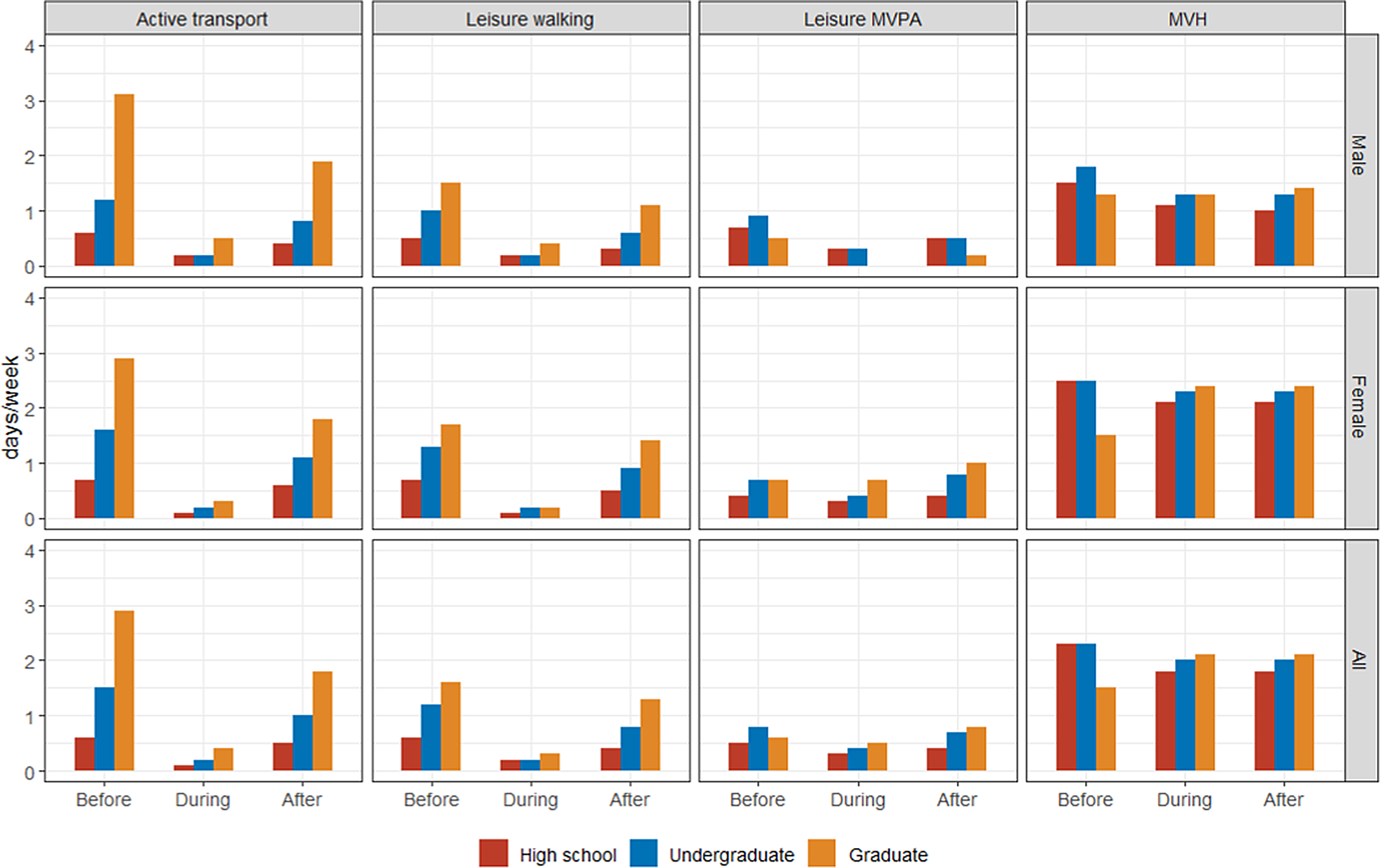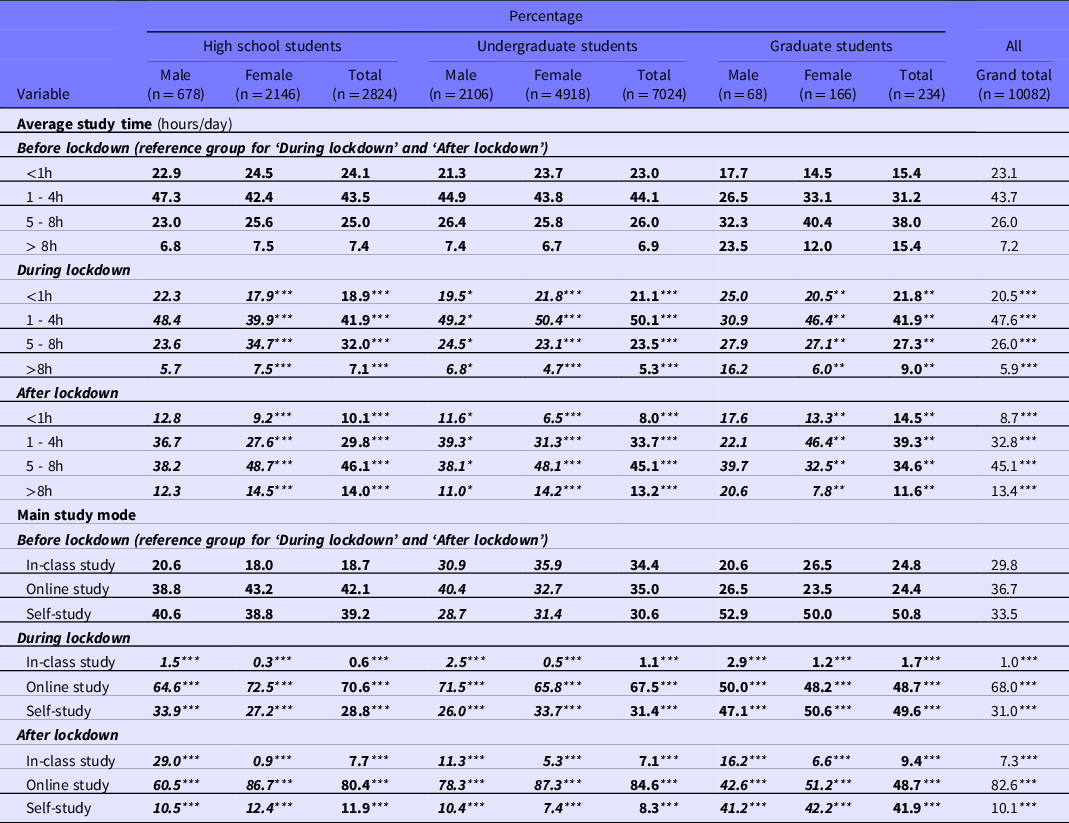Introduction
The Coronavirus disease 2019 (COVID-19) pandemic and subsequent lockdown measures for containing COVID-19 have affected human behavior and health at all ages. Reference Benita1,Reference Shakibaei, de Jong and Alpkökin2 The youth is one of the most vulnerable populations as the two major parts of their lives, study modes and physical activity (PA), may have been severely affected by lockdown measures, including school closure and ‘stay-at-home’ restrictions. Reference Rundle, Park and Herbstman3 Such influences could lead to both short-term and long-term effects in their academic achievements (also future career paths) and health status.
This study aimed to reveal how the youth’s study modes and PA patterns have changed through the COVID-19 epidemic in China, based on a large-sample national online survey. Our results would inform policymakers and educational administrators of the changed study and PA patterns among youths during COVID-19 lockdown for better policy making. Moreover, school administrators should be informed of those changes, so in-class and/or extracurricular PA programs could be designed to counteract them. The youths’ parents should also be aware of these changes, to better cooperate with school administrators for maximizing the effects of, for example, PA promotion programs, or to remind the youths of staying more active than usual while being at home.
Methods
This study was based on the COVID-19 Impact on Lifestyle Change Survey (COINLICS), a national retrospective survey distributed via social media platforms in early May 2020 using a snowball sampling method. Reference Jia, Liu and Xie4–Reference Luo, Wang and Yang7 More than 10000 youth participants at three educational levels (high school, college, and graduate school) in China have voluntarily reported their basic socio-demographic information and routine lifestyles in the months before (December 23, 2019 to January 23, 2020), during (January 24 to February 23, 2020), and after the COVID-19 lockdown (April 8 to May 8, 2020). The study was approved by the Sichuan University Medical Ethical Review Board (KS2020414).
This study focused on changes in four weekly PA patterns and two study patterns. PA patterns were measured using the International Physical Activity Questionnaire (IPAQ)-long form. Reference Craig, Marshall and Sjöström8 The frequency of engaging in active transport (i.e., walking and cycling) for commuting/ errands, leisure-time walking, leisure-time moderate-/ vigorous-intensity physical activity (MVPA), and moderate-/ vigorous-intensity housework (MVH) was reported as days/week (only counting outings that had lasted at least 10 minutes). Study patterns were measured as the daily average study time (hours/ day) and the major study modes (in-class, online, or self-study).
We calculated the weekly frequency of PA and the percentages of categorized study time and modes. The paired t - tests and χ2 tests were used for PA and study variables, respectively, to evaluate the significance of differences across educational levels, between sexes, and among three stages. All statistical analyses were performed using R 3.6.2 (R Foundation for Statistical Computing, Vienna, Austria) and statistical significance was declared if P < 0.05.
Results
A total of 10082 youths responded to the survey, among which 71.7% were females and 95.3% were Hans, with a mean age of 20. No significant differences were in the age and ethnic constitution between males and females. About 70% were undergraduate students, with 28% and 2.3% being high school and graduate students, respectively, and 63.2% lived in non-urban areas.
During the COVID-19 lockdown, the significant decreases were observed in the frequency of engaging in active transport for commuting/errands (1.3 to 0.2 days/ week), leisure-time walking (1.0 to 0.2 days/ week), leisure-time MVPA (0.7 to 0.3 days/ week), and MVH (2.3 to 2.0 days/ week) (Figure 1). Heterogeneities existed to different extents between sexes and across educational levels. For example, high school, undergraduate, and graduate students experienced decreases to different extents in the engagement of active transport for commuting/ errands (0.6 to 0.1, 1.5 to 0.2, and 2.9 to 0.4, respectively), leisure-time walking (0.6 to 0.2, 1.2 to 0.2, and 1.6 to 0.3, respectively), and leisure-time MVPA (0.5 to 0.3, 0.8 to 0.4, and 0.6 to 0.5, respectively); the level of MVH engagement decreased in only high school (2.3 to 1.8) and undergraduate students (2.3 to 2.0), and increased in graduate students (1.5 to 2.1), but with significant increases observed in only female (1.5 to 2.4) rather than male graduate students. After the lockdown was lifted, rebounds were observed in the frequency of engaging in active transport for commuting/errands (0.2 to 0.9 days/ week), leisure-time walking (0.2 to 0.7 days/ week), and leisure-time MVPA (0.3 to 0.7 days/ week), although still significantly lower than their corresponding levels before lockdown; a continuing decrease was only observed in the frequency of MVH (2.0 to 1.9 days/ week).

Figure 1. The participating youths’ physical activity patterns before, during, and after COVID-19 lockdown by sex and educational level (MVPA: moderate-/vigorous-intensity physical activity; MVH: moderate-/vigorous-intensity housework).
The average study time generally increased during lockdown (with more youths studying for 1 - 4 hours/ day and less studying for < 1 hour/ day), especially high school students, and further increased after lockdown, especially high school, and undergraduate students (Table 1). A main shift of study modes has been mainly from in-class to online study after implementing lockdown measures, with the percentage of conducting online study nearly doubled (from 36.7% to 68.0%); compared to undergraduate and graduate students, a larger percentage of high school students who mainly self-studied before lockdown also started online study. More self-studying high school and undergraduate students shifted to the online study after lockdown was lifted; about 6% of the youths were seen to resume in-class study.
Table 1. The participating youths’ study patterns before, during, and after COVID-19 lockdown by sex and educational level

*Values under a given variable were shown in bold, if the difference across educational levels (high school students, undergraduate students, graduate students) within the overall population (total) or within a given sex (male, female) was significant; shown in italic, if the difference between sexes within a given educational level was significant; and marked by asterisks, if the difference during or after COVID-19 within a given educational level and sex (relative to ‘before lockdown’) was significant (*P < 0.05, **P < 0.01, ***P < 0.001). P - values were based on χ2 tests.
Discussion
In this nationwide survey among youths in China, we observed significant decrease in the frequency of engaging in active transport for commuting/ errands, leisure-time walking, MVPA, and MVH during lockdown, with heterogeneities existing between sexes and across educational levels. After the lockdown was lifted, rebounds were observed in the frequency of all activities except MVH, which had further decreased. The average study time generally increased during lockdown, especially high school students, and further increased after lockdown, especially high school, and undergraduate students. A main shift of study modes has been mainly from in-class to online study after implementing lockdown. More self-studying high school and undergraduate students shifted to the online study after lifting lockdown.
The COINLICS has successfully accumulated a large sample size in the targeted population promptly for drawing strong conclusions, which is of particular importance in the context of public health emergencies. Reference Cohen, Lee and Long9 Our findings demonstrated the unique changing patterns of PA and studying in China, which have supported our hypotheses that social distancing and stay-at-home orders issued in many cities might reduce PA opportunities; also, school closure has changed the youth’s study modes and hence may further aggravate PA decreases.
There were some limitations in this study. First, COINLICS generated a convenience sample that may not be perfectly representative of the Chinese youth. Also, recalling what have happened about 2 - 4 months ago may be subject to recall bias. However, questions on each activity at three stages were placed next to each other, so their answers could reasonably be treated as good indicators for their lifestyle changes. Reference Luo, Zhang and Shen10 Second, variation in understanding the same questions among different individuals, especially across different educational levels, might affect the comparability of results among different educational groups. Third, the applicability of the IPAQ form to the current context need to be further evaluated.
Funding statement
The National Natural Science Foundation of China (42271433), Chengdu Technological Innovation R&D Project (2021-YF05-00886-SN), Sichuan Provincial Key R&D Program (23DYF2120), Wuhan University Specific Fund for Major School-level Internationalization Initiatives (WHU-GJZDZX-PT07), and the International Institute of Spatial Lifecourse Health (ISLE).




